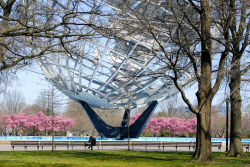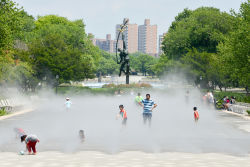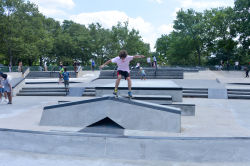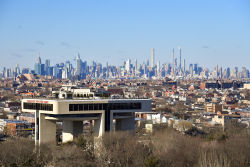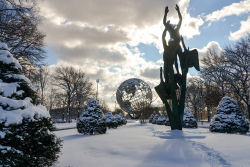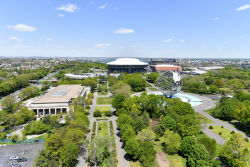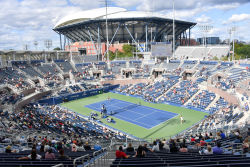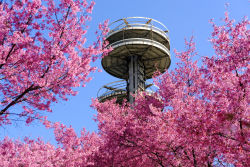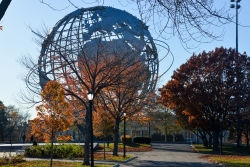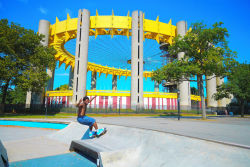Flushing Meadows Corona Park
Calvert Circle
This circle honors Calvert Vaux (1824-1895) the English architect who spent 40 years of his distinguished career in New York City. He designed private homes, public housing, apartment complexes, and public institutions such as the American Museum of Natural History and the Metropolitan Museum of Art. His partnership with Frederick Law Olmsted (1822-1903) generated the designs for Central Park, Prospect Park, Morningside Park, and Fort Greene Park.
Calvert Vaux, born in London, graduated from grammar school and his aptitude in math earned him an apprenticeship with a prominent architect. As an apprentice he learned contemporary styles and encountered others whose influence is evident in Vaux’s later work. In 1850, Andrew Jackson Downing (1815-1852) who developed the idea for Central Park with William Cullen Bryant (1794-1878), traveled to England, in part for a vacation, but with the primary goal of finding an architect to match his gardening abilities for his landscaping business. He found Vaux, and they returned to Newburgh, New York, designing houses and gardens in the Hudson Valley.
In 1850, Frederick Law Olmsted (1822-1903), a Connecticut born man who acquired little formal education and choose to learn about the world by traveling, had just returned from England. He turned his travel diary and the letters he sent home into a book, Walks and Talks of an American Farmer in England (although his father bought him two farms, working on them frustrated him) and excerpts were printed in Downing’s Horticulturist. Through the publishing, he met Downing and Vaux who agreed that a well-designed park could foster better character in the people who used them.
On July 28, 1852, Downing died on the steamboat Henry Clay, which had aboard a party of his friends and family. The boiler exploded, and rather than save his life, Downing stayed onboard the burning hulk, throwing deck chairs into the river for the escaping passengers to use as life-preservers. Vaux ran the landscaping company alone until 1856 when he moved to New York City and immediately involved himself with the scandal looming around the construction of Central Park.
In 1857, construction for Central Park began, and through a series of lucky coincidences, Olmsted acquired the position of Superintendent of Construction. Nonetheless, the initial plan for the park, which Olmsted efficiently put to action, fell short of the lofty ideals of beauty to which the commissioners overseeing Central Park aspired. They announced a design competition for a new plan and Vaux sought to enter, but he needed a partner who could provide him a wealth of first hand experience about the territory. He sough out the man he met seven years earlier in upstate New York and whose job it was to know every foot of the land: Frederick Law Olmsted.
Each holding other jobs while they planned their entry, the men worked at night during the winter of 1857-58 to create their vision of Central Park. The resulting design surpassed the others thanks to the combination of Vaux’s excellent rendering skills and Olmsted’s expert knowledge of the park’s topography. The team went on to design Prospect Park in Brooklyn as well as other urban parks throughout the country. In 1895, Calvert Vaux drowned under mysterious circumstances (some say it was suicide) in Gravesend Bay, Brooklyn.
This circle stands in front of Parks Olmsted Center, adjacent to Arthur Ashe stadium, in Flushing Meadows Corona Park. In this building, designers create the plans for all Parks projects from massive park renovations to animal art sculptures that adorn playgrounds. Using the names Olmsted and Vaux in and around the design center serves both as tribute to the great men who designed parks in the past and as inspiration for those people who design for our future.
Check out your park's Vital Signs
Clean & Safe
Green & Resilient
Empowered & Engaged Users
Share your feedback or learn more about how this park is part of a
Vital Park System

Know Before You Go

Downloads
- New York State Pavilion Listening Session
- Strategic Framework Plan: Introduction
- Strategic Framework Plan: Site Analysis
- Strategic Framework Plan: Conceptual Framework, Part I
- Strategic Framework Plan: Conceptual Framework, Part II
- Strategic Framework Plan: Vision and Goals, Part I
- Strategic Framework Plan: Vision and Goals, Part II
- Strategic Framework Plan: Appendix, Part I
- Strategic Framework Plan: Appendix, Part II
Links
- National Tennis Center Strategic Vision Project
- World Ice Arena
- Citi Field
- Mets Ticketing
- USTA National Tennis Center
- US Open
- Terrace on the Park Catering Hall
- New York Hall of Science
- Queens Museum
- Queens Botanical Garden
- Queens Theatre
- Queens Wildlife Conservation Center
- Fantasy Forest at the Flushing Meadows Carousel
- Wheel Fun Rentals
- Alliance for Flushing Meadows Corona Park
Contacts
General Park Info: (718) 760-6565
Pitch N Putt Golf and Miniature Golf : (718) 271-8182
World's Fair Marina on Flushing Bay : (718) 478-0480
World's Fair Marina Restaurant: (718) 898-1200
Terrace on the Park: (718) 592-5000
Citi Field: (718) 699-4220
Mets Ticketing: (718) 507-TIXX
USTA National Tennis Center: (718) 760-6200
US Open/USTA: (914) 696-7000
New York Hall of Science: (718) 699-0005
Queens Museum: (718) 592-9700
Queens Botanical Garden: (718) 886-3800
Queens Theatre: (718) 760-0064
Queens Wildlife Conservation Center: (718) 271-1500
Sports Permits: (718) 393-7272
Picnic/Barbeque Permit for Large Groups: (718) 393-7272
Wheel Fun Rentals: (917) 231-5519
World Ice Arena: (718) 760-9001
Al Oerter Recreation Center: (718) 353-7853
Flushing Meadows Corona Park Pool & Rink: (718) 271-7572
Special Events Permits: (718) 760-6560
Tennis Permits: (718) 393-7276
Volunteer Coordinator: (718) 760-6561

